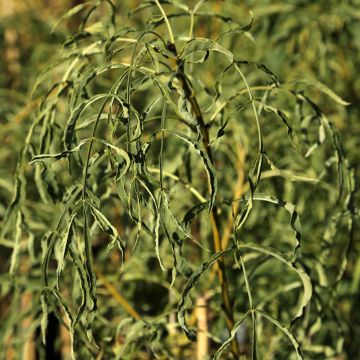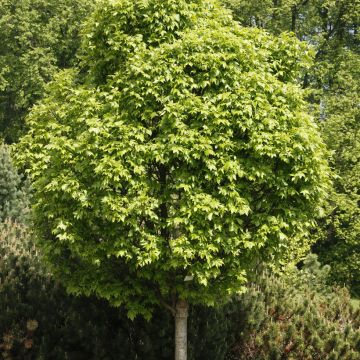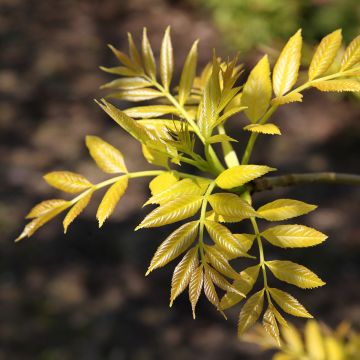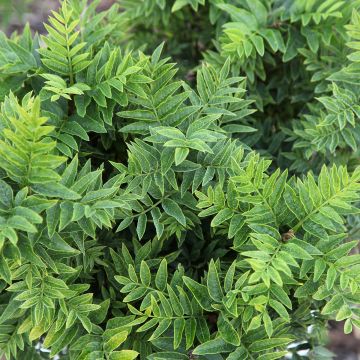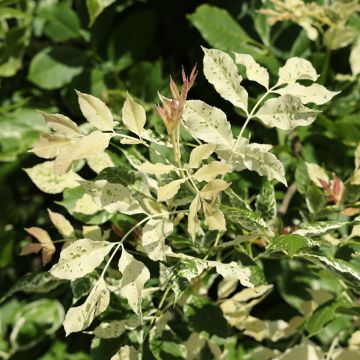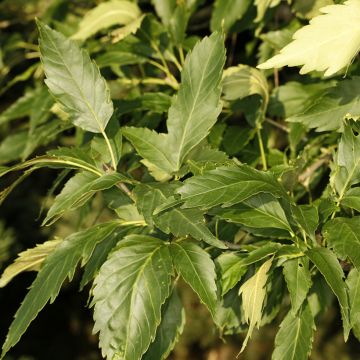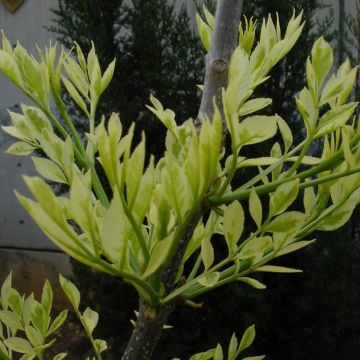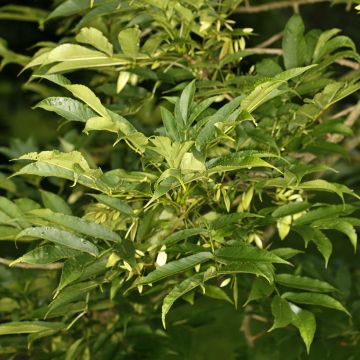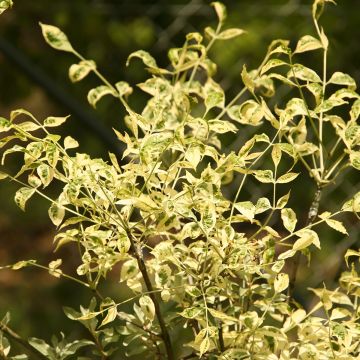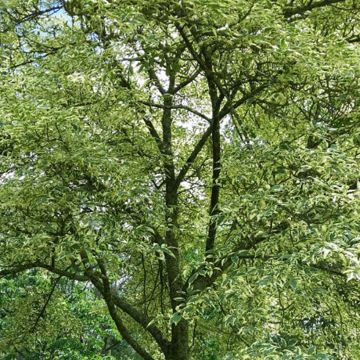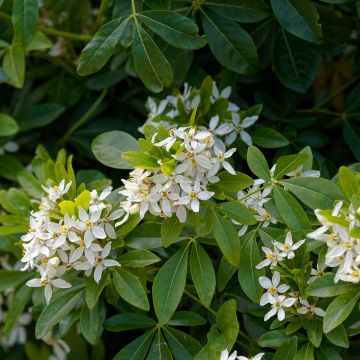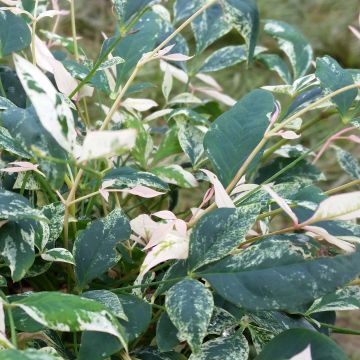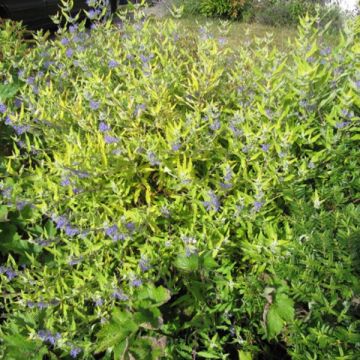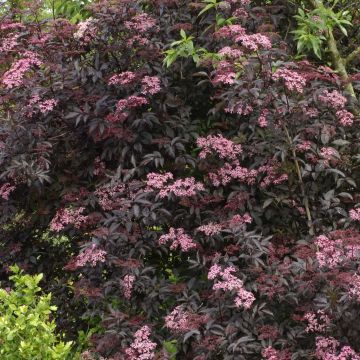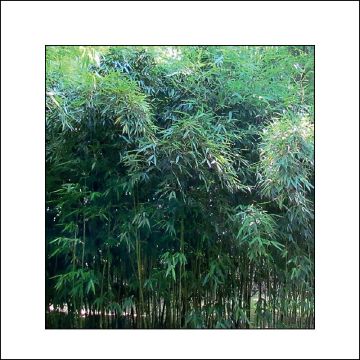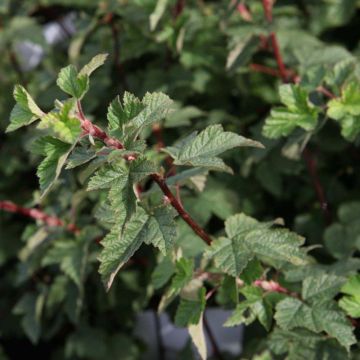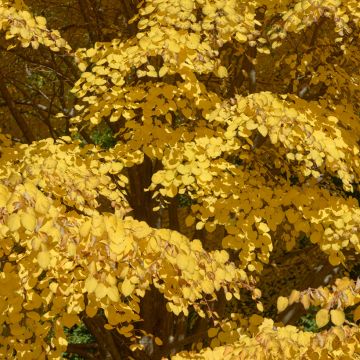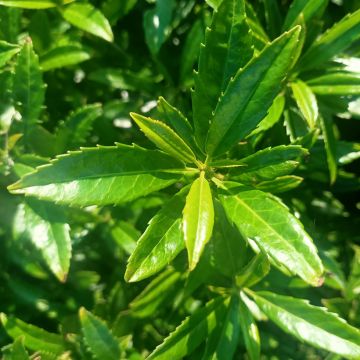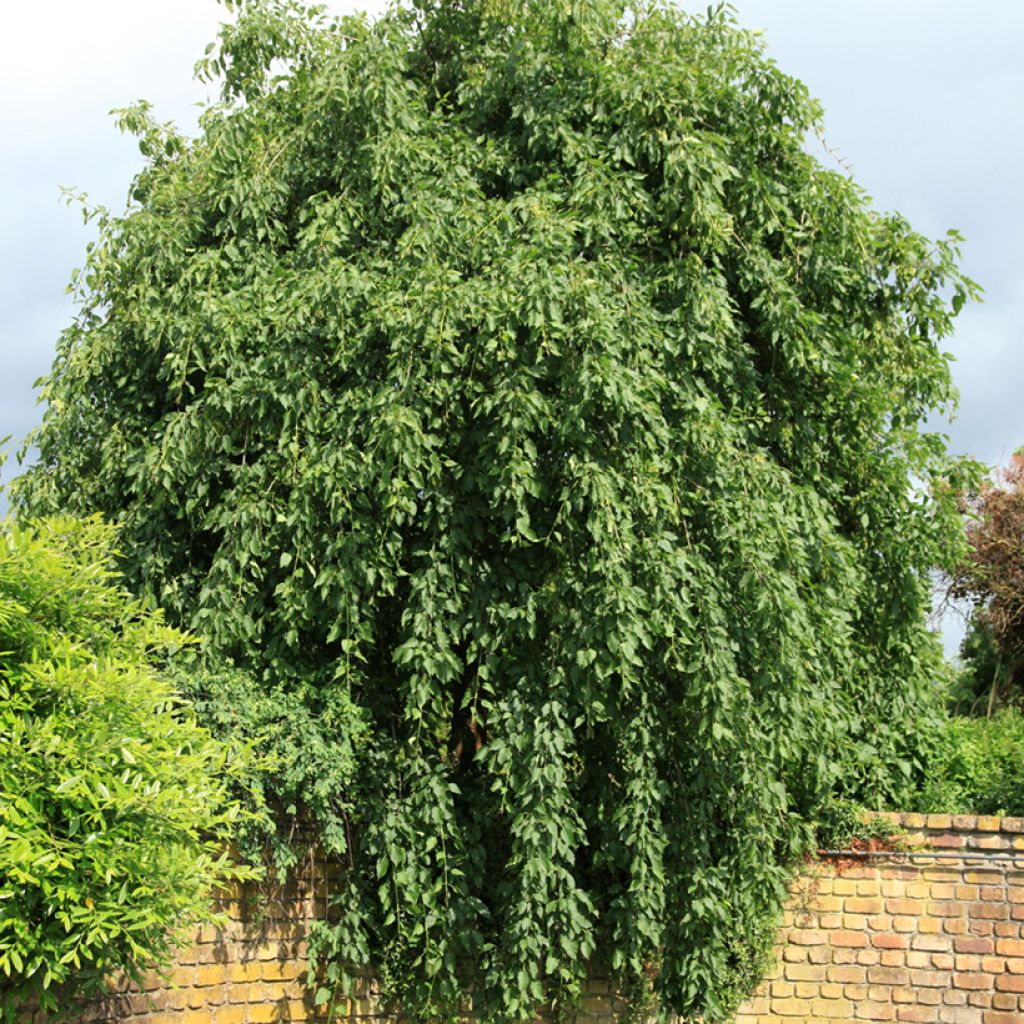

Fraxinus excelsior Heterophylla Pendula - Weeping ash
Fraxinus excelsior Heterophylla Pendula - Weeping ash
Fraxinus excelsior Heterophylla Pendula
Weeping ash, Common ash, European ash, Ash
Home or relay delivery (depending on size and destination)
Schedule delivery date,
and select date in basket
This plant carries a 24 months recovery warranty
More information
We guarantee the quality of our plants for a full growing cycle, and will replace at our expense any plant that fails to recover under normal climatic and planting conditions.
Does this plant fit my garden?
Set up your Plantfit profile →
Description
Fraxinus excelsior 'Heterophylla Pendula' or weeping ash is a small tree, typically as wide as it is tall, with flexible branches that bend almost to the ground. With moderate growth, its architectural silhouette deserves to be planted as a specimen tree, or within a bed of low-growing plants. Uncommon among ashes, its foliage consists of simple, entire leaves, not composed of leaflets like most other varieties. While its flowering is too insignificant to be ornamental, it turns beautiful yellow colours in autumn before leaf drop. A compact tree, easy to cultivate, well-suited for small gardens.
The Ash tree belongs to the Oleaceae family, like the Olive tree (Olea) which gave it its name, and several ornamental genera, such as Jasmines, Forsythias, or even Osmanthus which are so refined. Ash trees, of which around sixty-five species have been identified, are recognised, bar a few exceptions, including this variety, by their odd-pinnate leaves (composed of an odd number of leaflets, due to the terminal leaflet), usually opposite or sometimes grouped in threes. Fraxinus excelsior is the common Ash tree of European forests, and can also be found near lakes and rivers. With fast growth, it is a large tree that can exceed 30m in height. Its foliage consists of leaves composed of 7 to 13 leaflets, measuring 20 to 40cm in length, and it produces a very inconspicuous yellow-green flowering before bud burst.
Fraxinus excelsior 'Heterophylla Pendula' is different from the botanical species in several ways. With moderate growth, slower than the type, it eventually forms a small tree of 5 to a maximum of 6m in height, with a comparable spread, easily recognisable by its weeping habit. Its somewhat disorderly branching goes in all directions, horizontally or even upright towards the sky, but the long flexible branches arch and descend very low, practically to the ground. The resulting dome of vegetation is particularly architectural and attractive. The new shoots are a beautiful bright green, contrasting with the black buds characteristic of the species. At maturity, the shoots turn grey, like the trunk's bark. Interestingly, in this variety, the leaf blades are entire instead of being composed of leaflets (the cultivar 'Diversifolia' also has simple or compound leaves, but with only 3 leaflets). Their shape and size vary somewhat, hence the qualifier of heterophylla. With a beautiful bright green colour and prominent veins, the leaves have an irregular, more or less deep, toothed margin, and can even form small rounded lobes in some places. In autumn, the foliage takes on a fairly decorative yellow before falling to the ground. The flowering is too insignificant to be ornamental. It appears very early, in April, in the form of small yellow-green flowers, which then produce rather unattractive fruits called samaras.
Easy to grow in most moist and well-drained soils, not minding severe frost or wind and not very sensitive to de-icing salt, this 'Heterophylla Pendula' Ash tree is particularly well-suited for small urban gardens. Plant it as a specimen tree on a lawn to enjoy its characteristic silhouette, or even integrate it into a bed of diverse plants. In this case, surround it with low-growing plants to not hinder its development and allow it to display its attractive habit. Under its protective shade, you can plant a carpet of Pachysandra terminalis 'Variegata', an evergreen ground cover with dark green foliage delicately edged in white. The European Spindle Tree, or Euonymus europaeus, with its slightly wild appearance, will also blend well with your Ash tree and create a superb colour contrast when its foliage turns purple and red in autumn. Additionally, it produces very decorative pink and orange fruits (but be careful, they are also toxic). And to bring winter colours to your scene, adopt the Cornus stolonifera 'Flaviramea', a Dogwood with yellow wood that you can plant in front of your Ash tree without affecting it, as this shrub does not exceed 2m in height, and benefits from being pruned short each year to promote the growth of bright young shoots.
Report an error about the product description
Plant habit
Flowering
Foliage
Safety measures
Botanical data
Fraxinus
excelsior
Heterophylla Pendula
Oleaceae
Weeping ash, Common ash, European ash, Ash
Cultivar or hybrid
atteinterespiratoire
Cette plante peut entraîner des symptômes allergiques.
Evitez de la planter si vous ou vos proches souffrez de rhinite saisonnière ("rhume des foins").
Davantage d'informations sur https://plantes-risque.info
Other Fraxinus - Ash tree
View all →Planting and care
Plant your Fraxinus excelsior 'Heterophylla Pendula' in autumn or spring and choose a sunny but not scorching location with deep and well-drained soil. Even though it is small, keep in mind the space it will take at maturity to allow it to take its characteristic habit. If necessary, create a drainage pit with gravel if your soil is waterlogged. If your soil is poor, add leaf compost and planting compost. Water regularly during the summer following planting and make sure to protect it from prolonged droughts. Using mulch can help retain moisture and reduce the need for watering. Keep in mind that this riverside tree needs consistently moist soil, at least at depth. It is perfectly hardy. Prune every 3 years to balance the tree's habit by thinning out the centre of the canopy.
Planting period
Intended location
Care
This item has not been reviewed yet - be the first to leave a review about it.
Similar products
Haven't found what you were looking for?
Hardiness is the lowest winter temperature a plant can endure without suffering serious damage or even dying. However, hardiness is affected by location (a sheltered area, such as a patio), protection (winter cover) and soil type (hardiness is improved by well-drained soil).

Photo Sharing Terms & Conditions
In order to encourage gardeners to interact and share their experiences, Promesse de fleurs offers various media enabling content to be uploaded onto its Site - in particular via the ‘Photo sharing’ module.
The User agrees to refrain from:
- Posting any content that is illegal, prejudicial, insulting, racist, inciteful to hatred, revisionist, contrary to public decency, that infringes on privacy or on the privacy rights of third parties, in particular the publicity rights of persons and goods, intellectual property rights, or the right to privacy.
- Submitting content on behalf of a third party;
- Impersonate the identity of a third party and/or publish any personal information about a third party;
In general, the User undertakes to refrain from any unethical behaviour.
All Content (in particular text, comments, files, images, photos, videos, creative works, etc.), which may be subject to property or intellectual property rights, image or other private rights, shall remain the property of the User, subject to the limited rights granted by the terms of the licence granted by Promesse de fleurs as stated below. Users are at liberty to publish or not to publish such Content on the Site, notably via the ‘Photo Sharing’ facility, and accept that this Content shall be made public and freely accessible, notably on the Internet.
Users further acknowledge, undertake to have ,and guarantee that they hold all necessary rights and permissions to publish such material on the Site, in particular with regard to the legislation in force pertaining to any privacy, property, intellectual property, image, or contractual rights, or rights of any other nature. By publishing such Content on the Site, Users acknowledge accepting full liability as publishers of the Content within the meaning of the law, and grant Promesse de fleurs, free of charge, an inclusive, worldwide licence for the said Content for the entire duration of its publication, including all reproduction, representation, up/downloading, displaying, performing, transmission, and storage rights.
Users also grant permission for their name to be linked to the Content and accept that this link may not always be made available.
By engaging in posting material, Users consent to their Content becoming automatically accessible on the Internet, in particular on other sites and/or blogs and/or web pages of the Promesse de fleurs site, including in particular social pages and the Promesse de fleurs catalogue.
Users may secure the removal of entrusted content free of charge by issuing a simple request via our contact form.
The flowering period indicated on our website applies to countries and regions located in USDA zone 8 (France, the United Kingdom, Ireland, the Netherlands, etc.)
It will vary according to where you live:
- In zones 9 to 10 (Italy, Spain, Greece, etc.), flowering will occur about 2 to 4 weeks earlier.
- In zones 6 to 7 (Germany, Poland, Slovenia, and lower mountainous regions), flowering will be delayed by 2 to 3 weeks.
- In zone 5 (Central Europe, Scandinavia), blooming will be delayed by 3 to 5 weeks.
In temperate climates, pruning of spring-flowering shrubs (forsythia, spireas, etc.) should be done just after flowering.
Pruning of summer-flowering shrubs (Indian Lilac, Perovskia, etc.) can be done in winter or spring.
In cold regions as well as with frost-sensitive plants, avoid pruning too early when severe frosts may still occur.
The planting period indicated on our website applies to countries and regions located in USDA zone 8 (France, United Kingdom, Ireland, Netherlands).
It will vary according to where you live:
- In Mediterranean zones (Marseille, Madrid, Milan, etc.), autumn and winter are the best planting periods.
- In continental zones (Strasbourg, Munich, Vienna, etc.), delay planting by 2 to 3 weeks in spring and bring it forward by 2 to 4 weeks in autumn.
- In mountainous regions (the Alps, Pyrenees, Carpathians, etc.), it is best to plant in late spring (May-June) or late summer (August-September).
The harvesting period indicated on our website applies to countries and regions in USDA zone 8 (France, England, Ireland, the Netherlands).
In colder areas (Scandinavia, Poland, Austria...) fruit and vegetable harvests are likely to be delayed by 3-4 weeks.
In warmer areas (Italy, Spain, Greece, etc.), harvesting will probably take place earlier, depending on weather conditions.
The sowing periods indicated on our website apply to countries and regions within USDA Zone 8 (France, UK, Ireland, Netherlands).
In colder areas (Scandinavia, Poland, Austria...), delay any outdoor sowing by 3-4 weeks, or sow under glass.
In warmer climes (Italy, Spain, Greece, etc.), bring outdoor sowing forward by a few weeks.



































